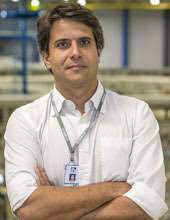Welcome to a LINXS webinar series introducing the latest scientific breakthroughs and developments at large scale research facilities from all over the world.
For the first time, Science Directors from different x-ray and neutron facilities will explore – together with the participants - the science, the methods, the applications and the collaborations carried out at their research site.
When: Wednesday, June 2, 2021, 15.00-16.00 CET
Speaker: Harry Westfahl Jr, Brazilian Synchrotron Light Laboratory (LNLS)
Title: Scientific opportunities at Sirius, the new Brazilian synchrotron light source
Please find the recorded webinar here!
BIO
Harry Westfahl Jr. is the LNLS’ Director since 2020. He also served LNLS as Scientific Director from 2013 to 2019, as deputy scientific director from 2011 to 2012 and, as a researcher since 2001, when he joined the Laboratory after three years of postdoctoral research. Since 2013 he coordinates the project and construction of the beamlines for the new Brazilian synchrotron light source, Sirius. Its main research interests are in the physics of condensed matter systems, in the use of synchrotron radiation for the study of materials, mainly polymers and magnetic materials, and in the development of synchrotron radiation instrumentation.
ABSTRACT
Sirius, the new fourth-generation Brazilian synchrotron light source, is currently under commissioning by the Brazilian Synchrotron Light Laboratory (LNLS). Its 3-GeV storage ring, based on a Multi-Bend Achromat (MBA) magnet lattice, provides electron beams with size and divergence that match the phase space of the x-ray photons, approximating their so-called diffraction limit for tender x-rays. The dramatic increase in brightness and transversely coherent photon flux from such improvement, combined with advances in mechatronics, optics, detectors, and computing, open new avenues of research within spatiotemporal scales previously inaccessible. The project initially foresees fourteen beamlines, six of which are in the final installation stages and initiating commissioning and will provide scattering, imaging, and spectroscopy capabilities spanning length scales from centimeters to angstroms. This presentation will highlight some complementary experimental capabilities and the scientific opportunities they will offer to explore the characteristics of biological, hierarchical, and condensed matter systems.
THE FACILITY
Please watch the short promo video of LNLS here!
Webinar moderators
Veronica Lattanzi ( veronica.lattanzi@biochemistry.lu.se ) and Anurag Kawde ( anurag.kawde@linxs.lu.se). Please contact the moderators for any questions or other queries.
During our events we sometimes take photographs and short film clips to profile our activities. Please let us know if you don’t want to be in any photos/films before we start the event. Some of the webinars are recorded to be used for educational purposes in the LINXS website.
By registering to our events you give your permission to LINXS, according to the General Data Protection Regulation (GDPR), to register your name and e-mail address to be used for the sole purpose of distributing newsletters and communications on LINXS activities.

